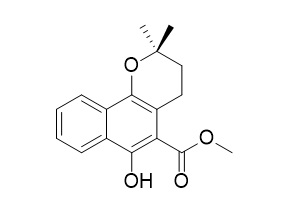Dihydromollugin
Reference standards.
Inquire / Order:
manager@chemfaces.com
Technical Inquiries:
service@chemfaces.com
Tel:
+86-27-84237783
Fax:
+86-27-84254680
Address:
1 Building, No. 83, CheCheng Rd., Wuhan Economic and Technological Development Zone, Wuhan, Hubei 430056, PRC
Providing storage is as stated on the product vial and the vial is kept tightly sealed, the product can be stored for up to
24 months(2-8C).
Wherever possible, you should prepare and use solutions on the same day. However, if you need to make up stock solutions in advance, we recommend that you store the solution as aliquots in tightly sealed vials at -20C. Generally, these will be useable for up to two weeks. Before use, and prior to opening the vial we recommend that you allow your product to equilibrate to room temperature for at least 1 hour.
Need more advice on solubility, usage and handling? Please email to: service@chemfaces.com
The packaging of the product may have turned upside down during transportation, resulting in the natural compounds adhering to the neck or cap of the vial. take the vial out of its packaging and gently shake to let the compounds fall to the bottom of the vial. for liquid products, centrifuge at 200-500 RPM to gather the liquid at the bottom of the vial. try to avoid loss or contamination during handling.
Invest New Drugs.2017, 35(2):166-179
Int J Nanomedicine.2024, 19:1683-1697.
Environ Toxicol.2020, doi: 10.1002
Plants (Basel).2021, 10(6):1192.
Eur Rev Med Pharmacol Sci.2020, 24(9):5127-5139.
J of Physics Conference Series2019, 1349(1)
Malaysian J of Fundamental and Applied Sciences 2018, 14(3):368-373
Chemistry of Plant Raw Materials2019, 4:135-147
J Appl Biol Chem.2022, 65(4):pp.463-469.
J Cachexia Sarcopenia Muscle.2022, 13(6):3149-3162.
Related and Featured Products
Phytochemistry, 28(12):3465-3468.
Anthraquinones and naphthohydroquinones from Rubia cordifolia.[Reference:
WebLink]
METHODS AND RESULTS:
Four naphthohydroquinones and their glycosides, and 11 anthraquinones and their glycosides were isolated from the dried roots of Rubia cordifolia var. pratensis. Six of them, Dihydromollugin, 2-carbomethoxy-3-(3′- hydroxy)isopentyl-1,4-naphthohydroquinone 4-O-β-glucoside, 2-methyl-1,3,6-trihydroxy-9,10-anthraquinone 3-O-β-glucoside, 2-methyl-1,3,6-trihydroxy-9,10-anthraquinone 3-O-(3′-O-acetyl)-α-rhamnosyl (1→2)-β-glucoside, 2-methyl- 1,3,6-trihydroxy-9,10-anthraquinone 3-O-(3′,6′-O-diacetyl)-α-rhamnosyl(1→2)-β-glucoside and 2-methyl-1,3,6-tri- hydroxy-9,10-anthraquinone 3-O-(4′,6′-O-diacetyl)-α-rhamnosyl(1→2)-β-glucoside, were isolated for the first time from a natural source.
CONCLUSIONS:
The structures were established by various chemical and spectroscopic methods. The chemotaxonomic significance of these findings is discussed briefly.
Journal of the Chinese Chemical Society, 2001,48(1):77-79.
Synthesis of Naturally Occurring Rubilactone, Mollugin, and Dihydromollugin of Rubia cordifolia.[Reference:
WebLink]
Rubilactone (1), Dihydromollugin (2), and mollugin (3) are naturally occurring products found in Rubia cordifolia, which is a famous Chinese herb with anti tumor, viral inhibition and other activities. Synthetic studies were carried out in these naphthoic acid esters starting from 1,4-dihydroxy-2-naphthoic acid.
METHODS AND RESULTS:
In this study, we finished the synthesis of rubilactone which has not been reported before and also synthesized Dihydromollugin and mollugin with better yields with different approaches compared to those previously reported in the literature.



